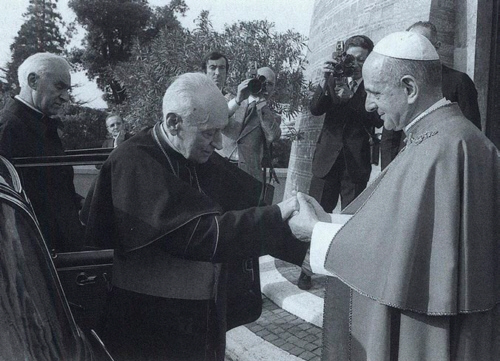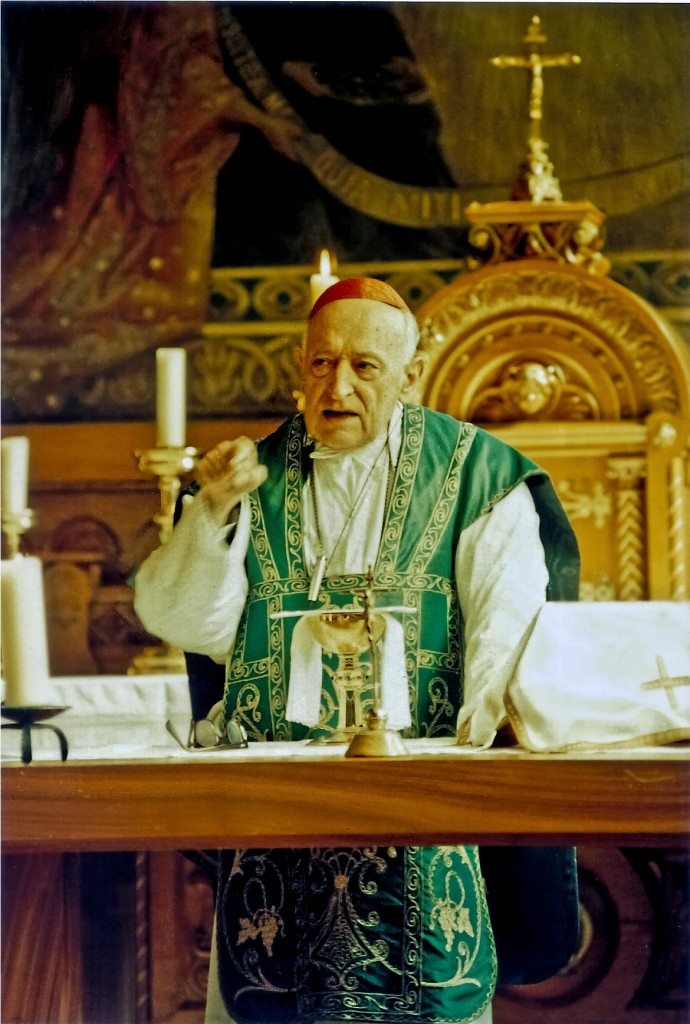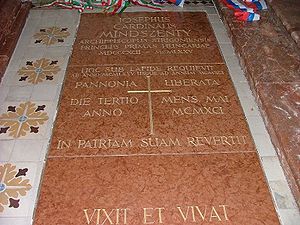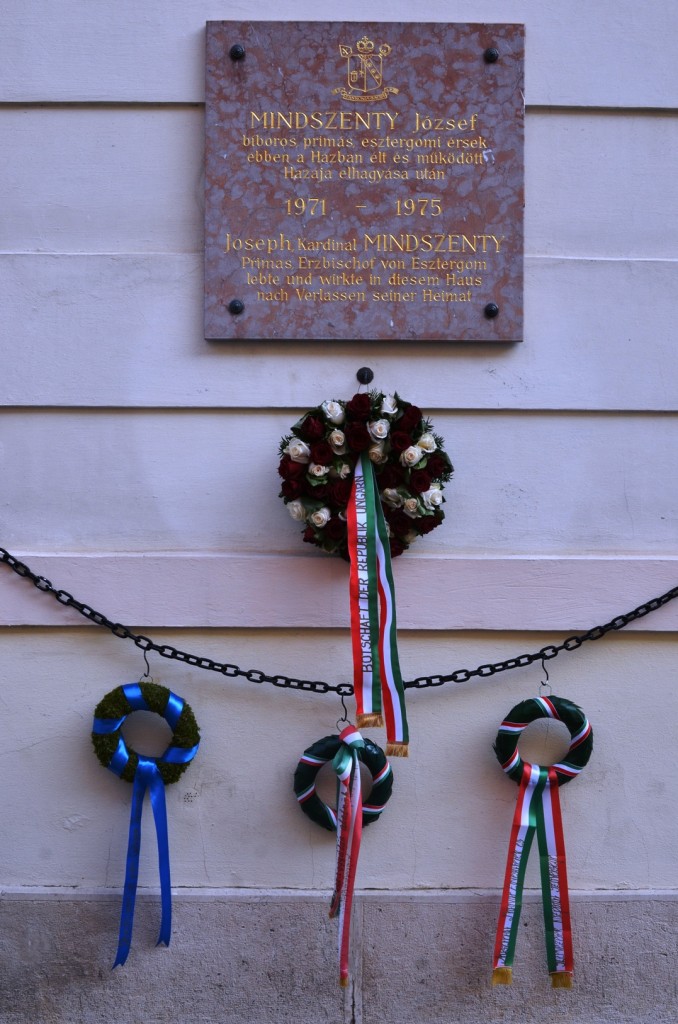Pope Paul VI and József Cardinal Mindszenty in Rome
This house was inhabited by Prince-Primate József Cardinal Mindszenty from 23rd October 1971 to 6th May 1975.
Following the events of 4th November 1956, after fifteen years’ house arrest in the US Embassy in Budapest, and at the request of Pope Paul VI, on 28th September 1971, Cardinal Mindszenty left the embassy, accompanied by the Viennese Apostolic Nuncio. Before leaving Hungary, he repeatedly said that he would like to remain in his homeland: “My wish is to spend my life in Hungary among my people, whom I love infinitely. If this were to prove impossible, because of an outburst of sentiment against me, or because considerations of a higher order from the Church should demand otherwise, then I accept what is likely to be the heaviest cross of my life.” He arrived in Rome via Vienna. They wanted to keep him there in Rome, but Cardinal Mindszenty decided to settle at the Pázmáneum in Vienna. With the knowledge of Cardinal Franz König, he was able to move “into his own place” – as he put it while still in Rome – as a completely independent and free person. Since the Cardinal did not want him to be feted or greeted, nobody knew of the exact date of his arrival. He did not want to attract attention or make any statements to the press. The then rector of the Pázmáneum was informed about the arrival only half an hour in advance. When Mindszenty arrived, he did not want to get out of the nunciature’s car in front of the building because of the reporters. He asked for the gates to be opened in order to drive in. After the key finally materialised, they drove through and Mindszenty got out, but only after the gates were closed. As living quarters within the rectorate, he chose – as a precaution – a room overlooking an inner courtyard. He lived in a simple, disciplined way, working and praying as always. From there he visited the emigrant exiled Hungarians, travelling around the whole world to where Hungarians had moved. Although these apostolic journeys served solely spiritual purposes, he always highlighted the difficult and disenfranchised state of his Hungarian homeland and the Hungarian Church. News reports attributed great significance to the release of Mindszenty, and abroad he was celebrated and received as a hero, which had not been expected back in Hungary. He was constantly rumoured to be a broken, sick man, incapable of leading an active life. According to the Hungarian communist authorities, he should be grateful that in his old age he had been saved from captivity and he should feel indebted to the Hungarian Government for letting him off his punishment and releasing him, allowing him to relax for the rest of his days. He himself, however, had no wish to live in seclusion and isolation at all. Having regained his freedom, he felt it his duty to be a spiritual support to the Hungarian diaspora. Those who had hoped for his death were surprised to find that he lived a very active life, working tirelessly, and that he was not in such a bad state of health as was so often rumoured about him. In fact, he was fine. This was also regularly reported by observers. “The Primate is a very mobile, but silent, somewhat cold personality. He works continuously. He eats fast. He has good hearing and is agile.” The then Hungarian Ambassador to Austria, in his report sent to the Ministry of the Interior, drew attention to the fact that a much higher level of propaganda had to be exerted against him than ever before. He emphasized: “I would consider it important especially now, when Mindszenty’s presence here is poisonous and is turning Austrian public opinion somewhat against us. With well-chosen propaganda materials, we could help to secure an even greater isolation for Mindszenty.” Not only inside the building did they keep everything and everybody under observation, but they were constantly spying in front of the Institute. (In 1968, Department 4 of the Ministry of the Interior Group Headquarters III/I opened a file code-named “Ostrom-Vár” – “Castle under siege” – for the collection of materials pertaining to the institute functioning at Boltzmanngasse 14. At the end of 1967, the intelligence agency ordered the examination of all incoming and outgoing mail of the Pázmáneum.) Suspecting this to be the case, Hungarians coming on visits to the building from their homeland would be very wary. Cardinal Mindszenty, however, “had many visitors, mainly because of his radiant personality,” said Rector Egon Gianone who was with him often. On 19th November, there took place the Cardinal’s first meeting with the Hungarians of Vienna, a greatly anticipated event. Mindszenty’s first official message at the altar was also transmitted to the world by the medium of television.
He said, “I am very glad that you have come in such numbers to this Mass. It is very good for us stateless Hungarians to be together. On every Sunday and feast day in Vienna there are a number of Hungarian priests who preach in Hungarian at Mass. Seek out these occasions, even at the cost of sacrifices! According to St. Paul, faith is heard. Every Sunday and every feast day seek out a Hungarian sermon. May God Bless You!” A few days later in the Stephansdom, Cardinal König introduced the Hungarian prince-primate to the people of Austria. Mindszenty preached in Hungarian and German, then the Archbishop of Vienna greeted the Hungarian Primate with fraternal words. This dual appearance, the concelebrated Mass of the Hungarian and Austrian Cardinals in the Cathedral of Vienna, was a historic moment. Common destiny was the theme of this historic scene, and at that moment everyone felt how right Mindszenty’s decision had been: the exiled Hungarian primate’s place was here in Vienna, in this “other” metropolis on the banks of the Danube. Cardinal König, Archbishop of Vienna, and the people of the Austrian capital welcomed him warmly. “It is a great honour for me to be Your host,” he said in his words of greeting, “… we hope You can enjoy peace and freedom for many years to come, here among us, in this city where so many of Your compatriots have found a second home.
József Mindszenty in the chapel of the Pázmáneum
At the end of April 1975 Mindszenty returned home, weak and sick, after a long South American pastoral journey. On the plane, although feverish, he talked about further trips. He planned to travel to France and Scandinavia in May. The final days of his life were spent in Vienna, at the Hospital of the Brothers of Mercy. At his request, his bed was set up so that he could see the tower of Stephansdom. According to the medical staff report, on 6th May at 14.15 he died a holy death. The broadcasting on Austrian radio was interrupted to announce the news of his death. He lay in state in Stephansdom and on 15th May was buried – temporarily, as per his request – at Mariazell. In his will he said: “When Moscow’s star of unbelief has disappeared from over the kingdom of Our Lady and St. Stephen, then take my body to the crypt of Esztergom basilica.” Cardinal König finished his funeral oration with these words: “Defunctus adhuc loquitur.” (cf. Hebrews 11: 4) The dead still speak.
Mindszenty’s grave in Mariazell
On 1st October 1990, the Mindszenty Foundation, as executor of the will, determined that the conditions for repatriation had been fulfilled and the date of the reburial was set for 4th May 1991. At dawn on 1st May, the excavation of the tomb in the Basilica of Mariazell was begun. The cardinal’s body, which according to witnesses was very well preserved, was placed in a new coffin and on the morning of 3rd May taken in solemn funeral procession to Esztergom. On 4th May 1991, in the basilica of Esztergom, the remains of József Cardinal Mindszenty, Prince-Primate, were laid to rest in the presence of tens of thousands of the faithful, accompanied by a solemn requiem mass and secular commemorations. The solemn requiem was celebrated in the square in front of the Basilica by Opilio Cardinal Rossi, personal representative of Pope John Paul II. At the rite of burial, the first to speak after Cardinal Paskai’s supplication and prayer was Prime Minister József Antal. He said, “Now as we take leave of József Mindszenty, as a country says goodbye to her great son who has returned to the seat of the ancient archdiocese, the petty arguments must be muted. May József Mindszenty’s return to his homeland give strength to this transformation and renewal.”
József Mindszenty’s grave in Esztergom
At the top of the marble slab closing the grave of the “most loyal pastor in persecution”, is engraved the Latin sentence “vita humiliavit, mors exaltavit” – “humiliated in life, exalted in death” and, in conclusion, “Hic in pace quiescit” – Here he rests in peace.
Wreathed memorial plaque on the side of the Pázmáneum





